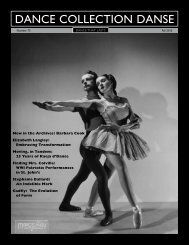DANCE COLLECTION DANSE
3E8Oe3fJp
3E8Oe3fJp
You also want an ePaper? Increase the reach of your titles
YUMPU automatically turns print PDFs into web optimized ePapers that Google loves.
Karen Kaeja in a solo she created for Allen Kaeja’s Asylum of Spoons (2004)<br />
Photo: Albert Camicioli<br />
tion wreaked by war and the Holocaust,<br />
such as Old Country (1995) and<br />
Resistance (2000). Seminal multidisciplinary<br />
works for Allen also include<br />
Lost Innocence (1992/93), a work for<br />
five dancers and two actors exploring<br />
the events of a displaced youth<br />
being brought into the arms of the<br />
Children’s Aid Society, and Armour/<br />
Amour (2011), which takes a magnifying<br />
glass to the architecture of the<br />
body and of the self. Combined, the<br />
two artists have deconstructed much<br />
thematic and physical territory and<br />
have been able to reach out to and<br />
emotionally engage with international<br />
audiences through the universal<br />
nature of many of their works.<br />
Within the Kaejas’s body of work<br />
are a significant number of dance<br />
films, twenty-six to date. Allen began<br />
working with multimedia in the<br />
1980s and soon became interested in<br />
using the camera as the third dancer.<br />
Karen also investigated dance on<br />
film during a course run through<br />
the Dance Umbrella of Ontario. In<br />
the mid-1990s, the pair began to<br />
focus their mutual interest on the<br />
convergence of film and movement,<br />
adapting several of their stage works<br />
for the camera including Witnessed<br />
(1997), Old Country (appearing first<br />
as a duet for TVOntario in 1994 and<br />
then for CBC Television in 2004)<br />
and Asylum of Spoons (2005). Witnessed<br />
is adapted from the stage<br />
work Courtyard and explores the<br />
displacement of ghettoized individuals<br />
during WWII, hearkening back<br />
to Allen’s family history. Shot in<br />
only one day, and edited over a few<br />
weeks, it has toured internationally<br />
and is now part of the permanent<br />
collection at New York’s Museum<br />
of Modern Art. They also found<br />
Allen and Karen Kaeja in Allen’s Resistance (2000)<br />
Photo: Cylla von Tiedemann<br />
some revelations in exploring this<br />
medium on the performative level:<br />
“Underneath, I am a shy person,”<br />
Karen says. “Film suited my personality<br />
as it is a private encounter<br />
with a camera, but it allowed<br />
me to communicate to many.”<br />
The Kaejas have also continued to<br />
make site-specific and audienceengaging<br />
performances a central<br />
aspect of their annual work. As early<br />
as 1987, they embarked on a multidisciplinary<br />
work titled Beare: a Celtic<br />
Odyssey, involving seven performers<br />
at the Winchester Street Theatre with<br />
live music by Loreena McKennitt and<br />
script by Allen. More recently, they<br />
have performed as part of Toronto’s<br />
Nuit Blanche. In Stable Dances (2008),<br />
they sourced from a previous<br />
site-specific work (Bird’s Eye View) to<br />
create an all-night installation in the<br />
historic stables and carriage rooms of<br />
Casa Loma for a revolving audience,<br />
incorporating live video projections,<br />
with music by Edgardo Moreno and<br />
over twenty performers. They are<br />
also the masterminds behind annual<br />
outdoor community events such as<br />
Porch View Dances.<br />
The Kaejas are prolific teachers<br />
in the Toronto dance community<br />
and beyond. Indeed, their teaching<br />
20 Dance Collection Danse




